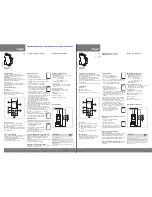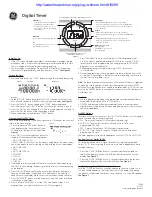
NOVUS AUTOMATION
1/5
NT240 TIMER
PROGRAMMABLE TIMER – INSTRUCTIONS MANUAL V20x D
INTRODUCTION
The NT240 is a programmable timer designed to monitor time
intervals, activating its outputs according to some predefined mode of
operation and time intervals chosen by the user. The user can also
create its own mode of operation to best fit his application.
The timer shows the elapsed time in an increasing or decreasing
mode, with resolutions from 0.01 s to 1 hour.
Digital inputs are available to perform specific functions. Standard
outputs are relay and logic pulse (5 V) types.
SPECIFICATIONS
Input types: - NPN/PNP sensors
- NO/NC dry contact
- Voltage: Logic level 1: 5 to 30 Vdc
Logic level 0: -0.5 to 0.5 Vdc
Output: - 1 SPST Relay 3 A / 250 Vac (3 A / 30 Vdc)
- 1 voltage pulse 5 V / 25 mA
Time delay after turning on the timer: 200 ms
Accuracy: 0,1 % of displayed time
Response time: 10 ms for the relay output and 0.3ms for the pulse
output
Auxiliary voltage source: 12 Vdc ±10 % / 50 mA
Power: 100 to 240 Vac/dc (±10 %), 50/60 Hz or optional 24 V: 12 to
24 Vdc / 24 Vac (-10 % / 20 %)
Maximum consumption: 3 VA
Operating environment: 0 to 55 ºC, Relative humidity (maximum): 80 %
up to 30 ºC. For temperatures above 30 ºC, decrease 3 % per ºC.
Dimensions: 48 x 48 x 106 mm
Cut for panel fixation: 45.5 to 45.5 mm
Approximate weight: 150 g
TIMER INPUTS
The timer has three control inputs: START, HOLD and RESET.
These inputs can be configured to accept four different electrical
(logical) signals (see parameter
PnP
in the configuration). The signal
type there defined becomes the same for all three inputs.
START: Starts time counting
The start input, when activated, starts the temporization cycle, using
the operating mode selected in the configuration. The START input is
available on terminals 9 and 12.
HOLD: Interrupts time counting
The HOLD input, while active, interrupts time counting. When the
HOLD input is released, the time counting resumes from the point it
was interrupted.
NOTE: The HOLD function can activated by the
F
key, when
programmed to perform as such on the
F
Fv
parameter of the timer.
Using the
F
key as the input to HOLD function, pressing once
stops the timer and pressing again resumes the counting of time.
RESET: Timer Input Reset
The Reset input, when activated, cancels the current temporization
and returns the timer display to the initial value. While Reset is
active, the temporization can not be started. When Reset is released,
the timer becomes available for new temporization.
TIMER OUTPUTS
The timer provides an output, called TIMER OUTPUT, which can be
activated in various ways according to the selected temporization
mode. This output is available as a relay contact and as a voltage
pulse (both operate simultaneously).
Output types: 1 SPST – 3 A / 250 Vac relay, terminal 3 and 4;
1 voltage pulse of 5 V / 25 mA, terminals 5 and 6
Output delay time: 10 ms for relay output;
0.3 ms for pulse output.
The
0Per
parameter defines the way the output will operate.
AUXILARY SUPPLY OUTPUT
A 12 Vdc
±
10 % (50 mA max) auxiliary power supply is provided on
terminals 7 and 8 to power electronic sensors used as inputs to the
timer. The (-) supply terminal is wired internally to the GND terminal
of the inputs (the supply is not electrically isolated from the
inputs).
INSTALLATION
Panel Mounting
Insert the unit into the panel cut-out (use the dimensions specified in
the "Technical Specifications" section) and slide the mounting clamp
from the rear to a firm grip at the panel.
The timer circuitry can removed from its case from the front, without
the need of disassembling the instrument from the panel, leaving the
wire connections intact.
Electric connections
Figure 01 shows the timer terminals along with theirs functions.
Figure 01 – Timer connections panel
Recommendations for Installation
•
Input signal wires should be laid out away from power lines and
preferably inside grounded conduits.
•
Instrument mains should be suitable for this purpose and wires
should not be shared with high consumption motors and inductors.
•
Use of RC filters (47
Ω
and 100 nF) in parallel with solenoids and
contactor coils are highly recommended.
•
In monitoring and control applications it is essential to consider
what can happen when any part of the system is subject to failure.























